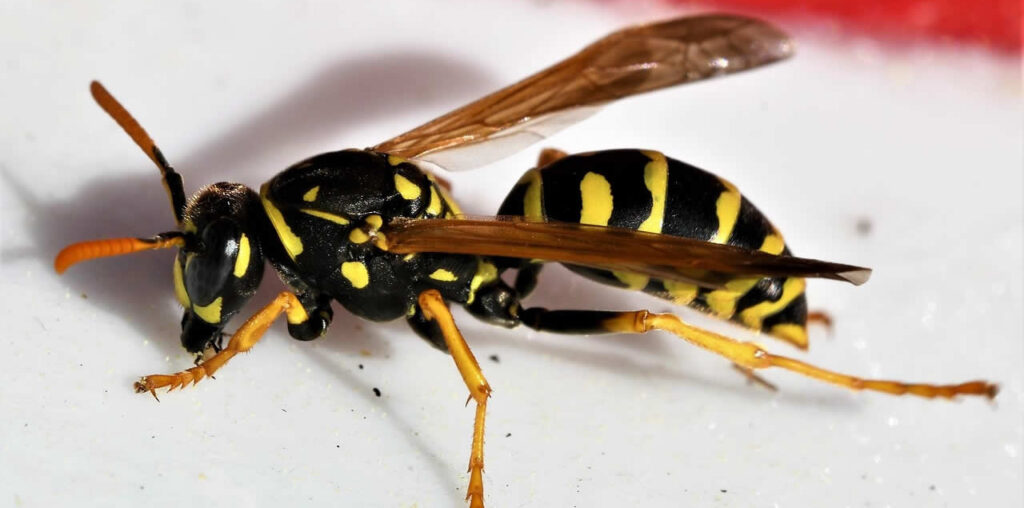Wasps and hornets are often confused due to their similar appearance and behaviour. However, there are key differences between these two types of insects that set them apart.
Understanding the distinctions between wasps and hornets can be beneficial whether you’re a gardener, a homeowner, or just someone who wants to avoid painful stings.
Here, we will explore their physical characteristics, behaviour, habitats, and their impact on the ecosystem.
Physical Differences
Size and Appearance
One of the most noticeable differences between wasps and hornets is their size. Hornets are generally larger than wasps. While most wasps range between 10-20mm (0.4-0.8 inches) in length, hornets can grow to 25-40mm (1-1.5 inches) or more, depending on the species.
In terms of appearance:
- Wasps tend to have slender bodies with a more defined waist and long, thin legs. They often have bright yellow and black markings.
- Hornets tend to have thicker, more robust bodies with a less defined waist. Their colouration is usually a mix of yellow, orange, and brown, with some species featuring reddish hues.
Colouration
Wasps are typically bright yellow and black, whereas hornets often have more muted tones of yellow, brown, and red. This difference in colouration can help distinguish between the two.
Wings and Antennae
Both wasps and hornets have two pairs of wings, but hornet wings often appear more reddish-brown. Their antennae are also slightly thicker and more curved than those of common wasps.
Behavioural Differences
Aggression and Stinging Behavior
Both wasps and hornets can sting, but hornets are generally less aggressive toward humans unless provoked. Wasps, particularly yellowjackets, are more territorial and likely to sting multiple times if they feel threatened.
- Wasps: Can sting multiple times since their stinger is smooth and does not get stuck in the skin.
- Hornets: Have more powerful venom than wasps, making their stings more painful. However, they are less likely to sting unless their nest is disturbed.
Diet and Feeding Habits
Both wasps and hornets are omnivorous and feed on a variety of foods, including nectar, fruit, and other insects.
- Wasps: Often scavenge human food and are attracted to sugary drinks, meats, and leftovers.
- Hornets: Prefer a diet of live insects, making them more efficient natural pest controllers.
Nesting Differences
Wasp Nests
Wasps build their nests from chewed wood fibres mixed with saliva, forming a paper-like material. Their nests are often found:
- Under eaves and roofs
- In wall cavities
- In trees and shrubs
- In the ground (for some species like yellowjackets)
Hornet Nests
Hornet nests are more enormous and more enclosed, often shaped like a football or teardrop. These nests are typically found:
- High up in trees
- In attics and sheds
- In dense shrubbery
Hornets generally build their nests in more secluded locations, whereas wasps may create nests in more open areas, including near human activity.
Lifespan and Colony Structure
Wasp Colonies
Wasps have annual colonies, meaning they die off in winter, except for the queen, who hibernates and starts a new colony in the spring.
Hornet Colonies
Hornets follow a similar life cycle to wasps but often build larger and more structured colonies. A single hornet nest can contain several hundred workers by the peak of summer.
Ecological Role
Pollination
Both wasps and hornets play a role in pollination, but they are not as effective as bees. However, their foraging habits still contribute to plant reproduction.
Pest Control
Hornets are particularly effective at controlling pest populations, as they feed on flies, caterpillars, and other insects. Wasps also contribute to pest control but are more likely to scavenge.
How to Deal with Wasps and Hornets
Prevention Tips
- Keep food covered when dining outdoors to avoid attracting wasps.
- Seal trash bins to prevent scavenging.
- Inspect your home for potential nesting sites in early spring.
- Use wasp repellents like peppermint oil or vinegar sprays.
Safe Nest Removal
If you find a wasp or hornet nest near your home, it’s best to call a professional pest control service rather than attempt to remove it yourself. Disturbing a nest can provoke aggressive behaviour, leading to multiple stings. A professional will have the necessary equipment and training to safely remove the nest.
Continuing Education
If you want to learn more about wasps, hornets, and other stinging insects, there are many resources available online and in print. Check your local library for books on insect identification and behaviour. You can also attend workshops or lectures offered by entomologists or pest control professionals.
Understanding these crucial pollinators can help you coexist with them peacefully and safely. In addition, knowing how to identify different types of stinging insects can be critical in an emergency situation where medical attention is needed.
Final Say!
While wasps and hornets share many similarities, they have key differences in size, behaviour, diet, and nesting habits. Understanding these differences can help identify them and manage their presence more effectively.
Though they may be intimidating, both wasps and hornets play an essential role in the ecosystem by controlling pests and contributing to pollination. Knowing how to coexist with them safely ensures a balanced and thriving environment.




